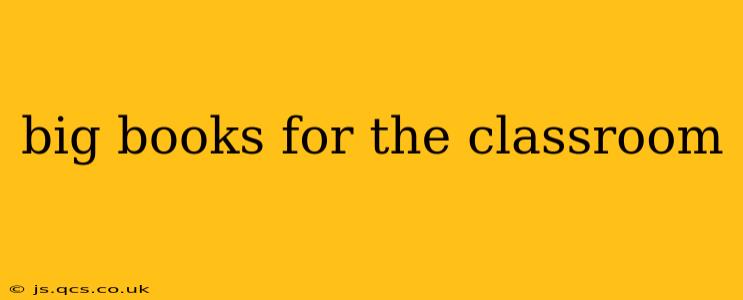Big books are a cornerstone of early childhood education, offering a powerful tool for fostering literacy skills and a love of reading. These oversized, engaging books provide a unique shared reading experience that benefits both teachers and students. But choosing the right big books for your classroom can feel overwhelming. This guide will help you navigate the world of big books, exploring their benefits and offering suggestions for selecting the perfect titles for your students.
What Makes a Big Book Effective?
Effective big books go beyond simply being large; they are thoughtfully designed to facilitate interactive reading and learning. Key characteristics include:
- Large Print and Engaging Illustrations: The oversized text allows for easy viewing by the entire class, while vibrant illustrations capture children's attention and support comprehension.
- Repetitive Text and Predictable Patterns: These elements encourage active participation, allowing children to join in the reading process and build confidence.
- Thematic Focus: Many big books center on specific themes, providing opportunities for rich discussions and related activities.
- Durable Construction: Designed to withstand repeated handling by small hands, big books need to be robust and long-lasting.
Benefits of Using Big Books in the Classroom
Big books offer a multitude of benefits for young learners:
- Develops Phonological Awareness: The repetitive nature of the text helps children recognize rhyming words and sounds, crucial for early literacy development.
- Enhances Vocabulary: Exposure to new words and phrases expands children's vocabulary and language skills.
- Builds Print Awareness: Children learn about the directionality of text, the concept of words and sentences, and the relationship between spoken and written language.
- Fosters a Love of Reading: The shared reading experience creates a positive and engaging environment, encouraging a lifelong love of books.
- Supports Social-Emotional Learning: Shared reading time builds community and strengthens classroom bonds.
What Types of Big Books are Available?
The range of big books available is extensive, encompassing various themes, styles, and reading levels. You can find big books focused on:
- Alphabet and Phonics: These books introduce letters and sounds in an engaging way.
- Numbers and Counting: Perfect for developing early math skills.
- Seasonal Themes: Celebrating holidays and seasonal events.
- Social-Emotional Learning: Addressing topics like friendship, feelings, and self-esteem.
- Storytelling: Engaging narratives that capture children's imaginations.
How to Choose the Right Big Books for Your Classroom
Selecting appropriate big books involves considering the age and developmental level of your students, as well as their interests and learning needs. Here are some tips:
- Consider your curriculum: Align your big book choices with your overall curriculum goals.
- Prioritize engagement: Choose books with captivating illustrations and storylines that resonate with your students.
- Think about diversity and representation: Select books that reflect the diversity of your classroom and the wider world.
- Don't be afraid to experiment: Try different types of big books to find what works best for your students.
Where Can I Find Big Books?
Big books can be purchased from various educational suppliers, online retailers, and bookstores. Many libraries also have collections of big books available for loan.
How Can I Use Big Books Effectively in My Classroom?
Utilizing big books effectively goes beyond simply reading the text. Here are some interactive strategies:
- Shared Reading: Engage the whole class in reading, encouraging participation and choral reading.
- Interactive Activities: Incorporate activities such as puppets, finger plays, or art projects related to the book's theme.
- Vocabulary Development: Discuss new words and their meanings, encouraging students to use them in sentences.
- Comprehension Questions: Ask questions to check for understanding and stimulate critical thinking.
What are some examples of good big books for the classroom?
This is highly dependent on the age and developmental stage of your students. However, authors like Eric Carle (The Very Hungry Caterpillar), Mem Fox (Time for Bed), and Bill Martin Jr. (Brown Bear, Brown Bear, What Do You See?) are consistently popular choices for their engaging text and illustrations. Exploring booksellers specializing in early childhood education will yield many more suggestions based on specific needs.
By thoughtfully selecting and utilizing big books, you can create engaging and enriching learning experiences that nurture a lifelong love of reading in your students. Remember that the key is to create an interactive and enjoyable shared reading experience that caters to the specific needs and interests of your class.
